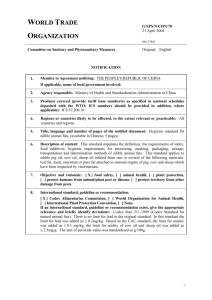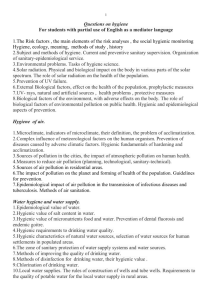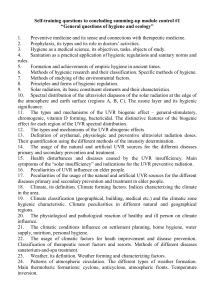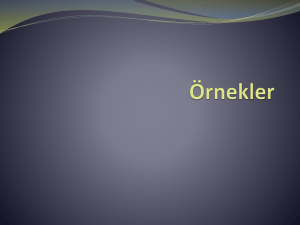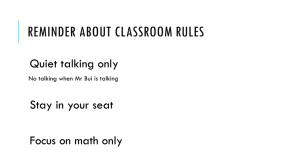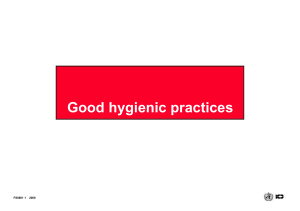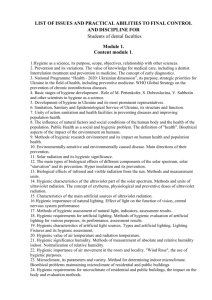Conformities to the law of growth and development of child`s
advertisement
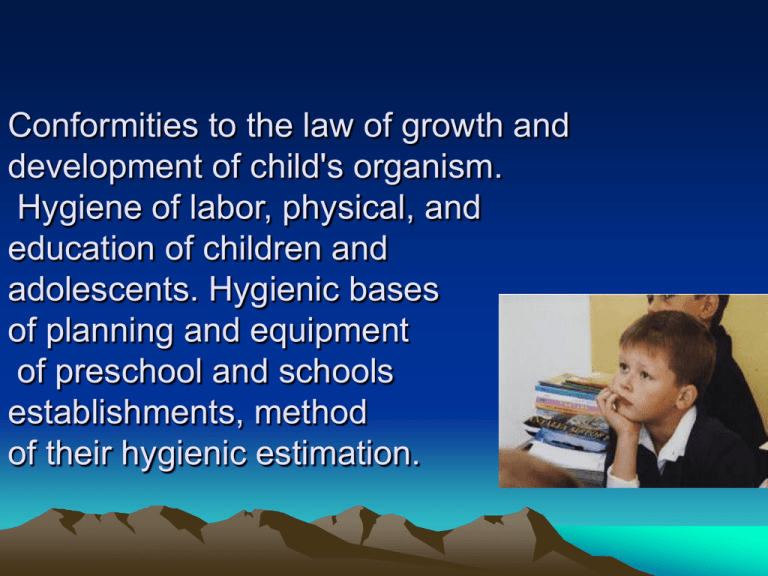
Conformities to the law of growth and development of child's organism. Hygiene of labor, physical, and education of children and adolescents. Hygienic bases of planning and equipment of preschool and schools establishments, method of their hygienic estimation. Age periods • Social periods, based on experience with child and adolescent contingents, establishes the following age periods: • Pre-preschool to 3 years; • Preschool from 3 to 7 (6) years; • primary school from 7 (6) to 10 years; • secondary school from 11 to 14 years; • Teenager from 15 to 18 years . Biological periods • • newborn, 1 to 10 days; • chest age from 11 days to one year; • early childhood from 1 to 3 years; • first childhood from 4 to 7 years; • second childhood: boys 8 to 12 years, girls from 8 to 11 years; • adolescence: boys from 13 to 16 years, girls from 12 to 15 years; • Youth age: young men from 17 to 21 years, girls from 16 to 20 years. Types of higher nervous activity • Optimal stimulant, balanced, fast (reaction force adequate stimuli, the bark of the brain is in a state of optimal efficiency, conditional reflexes stable, are easily and quickly, children friendly, optimistic, disciplined). • Optimal stimulant, tranquil, indolent (slow and conditioned reflex formed slowly but is stable, the children have sufficient linguistic reserve, quiet, persistent, disciplined). • Strong, raised-inflammatory, unbalanced (reduced function of adjusting the brain cortex, the processes of excitation substantially predominate over the process of braking reaction quite often inadequate, there is heightened emotions, sometimes even aggressive). • The weak, reduced-inflammatory (conditional reflexes are formed slowly, internal braking weak, strong stimuli cause rapid fatigue, there is a tendency to nervous disorders. Criteria for evaluating health • presence or absence at the time of the survey of chronic diseases level of functional state of the basic body systems; degree of resistance, adverse effects of environmental factors; level achieved by physical and neuropsychological development and the degree of harmony. • The first group includes children and adolescents with no chronic disease, not sick, or rarely sick, have normal physical and neuro-psychological development, which corresponds to their age and articles. Training, employment and sports activities for the children to organize without restriction. The doctor holds only a routine preventive examination and generall measures. • The second group include children and adolescents who have chronic diseases, but have some functional and morphological deviations that affect their health and work, and who often suffer longterm. These are children at risk and for them the doctor creates a set of health measures aimed at prevention of chronic diseases. This package includes recommendations to improve hygiene body resistance through non-specific measures. This hardening of the body due to natural factors, rational mode of the day, additional vitaminization. Tests conducted on an individual basis. • The third group includes children with chronic diseases or offset innate pathology with particular chronic diseases, mild, a little disturbed when the general condition and health. This ill children and adolescents in a state of compensation. They are at the dispensary observation of doctors in different profiles and receive appropriate treatment and prevention need help. The peculiarity of the learning process for them is the soft mode of day, a long rest and a good night sleep, limit physical exertion. • In 4 of the first group includes children with chronic or congenital defects in the state subcompensation in which disturbed general condition and health. These children should be special attention, the doctors of various specialties should children's health according to current guidelines, and in children's institutions for these children creates a special regime. • In the 5th group enrolled children and adolescents with serious chronic diseases in the state of decompensation and significantly reduced functionality. They are under constant supervision of doctors. Mechanisms of rank distribution of diseases in different age groups Rank position I 0–14 Respiratory diseases II Diseases of the nervous system and sense organs III IV ... Diseases of the digestive system Diseases of the endocrine system V Diseases of skin and subcutaneous tissue 0–6 7–14 15–17 Respiratory diseases Respiratory diseases Respiratory diseases Diseases of the nervous system and sense organs Diseases of the nervous system and sense organs Diseases of skin and subcutaneous tissue Diseases of the digestive system Diseases of Diseases of the blood and organs endocrine system Infectious and Diseases of the musculoskeletal parasitic diseases system Diseases of the nervous system and sense organs Diseases of the digestive system Diseases of the endocrine system Diseases of the musculoskeletal system Occupational physical development... 1) Somatoscopic criteria Condition bone muscle apparatus Forms chest, back The degree of sexual maturation The main types of attitude The main types of attitude (a - lordosis b - kyphosis; in - correct d - stooped, D - straightened) Gradually FORMATION arch axis due to the child seat (1), holding PRESIDENT (2) and stand (3). Methods of measuring the depth of the physiological curves of the spine and the main types of scoliosis Methods of measuring the depth of the physiological curves of the spine (1) and the main types of scoliosis (2) (1-4 - length of the spine, 2 - cervical curve, 3 - lumbar curve; and - December rightside b - total nearside c - S-shaped) Curvature of the spine scoliosis Type chest Type II flat chest. Second cone. III cylindrical Plantography Determination of the flat foot Forms of foot extremities Forms of lower extremities (a - a normal, b - X-shaped, and in - like O ) 2) Somatometric criteria The length of the body and its individual parts Weight Diameter and stroke 3) physiometric criteria is blood preassure , muscular strength, pulse. Evaluation of physical development • 1) method sygmal deviations 2) evaluation of physical development on a scale regression 3) complex method Profile of physical activity Factors that shape health • Among the favorable factors include: Rational treatment of daily activities. Adequate and balanced nutrition. Compliance with environmental hygienic requirements. Optimal motor mode. Hardening. Availability of hygienic habits and a healthy lifestyle. • Among the adverse factors include: the educational process. Shortcomings in the food. Violation of hygienic requirements for the gaming environment, training and employment. Insufficient or excessive motor activity. • Unfavorable psychological climate in the family and the community. Lack of hygienic habits, the presence of harmful habits. Hygiene requirements for the planning, development, equipment pre-school institutions and schools • The basic principles of hygienic design of pre-school institutions are: - Compliance group isolation; - Creating a favorable air-thermal; - Ensure optimal lighting and insolation; - Ensure the physical activity of children; - Creation of conditions for sustainable food; - Of indoor applications. The basic principles of hygienic design schools are: • - Providing an enabling environment for the educational process; - Ensure optimal light regime; - Creating conditions for physical education; - Creating conditions for Guidance; - Ensure the rational organization of food students; - Create conditions for recreation for children and adolescents; - Creation of conditions for organization of cultural and media work. Children's Institutions • To child care are: kindergartens (nursery, kindergarten) children's education (secondary and special schools - high school, grammar school - a different type) and Extracurricular (palaces, homes of children and youth, summer camps) institutions. Radius service child care • For preschool radius service should be 0,3-0,5 km for school children - to 0.5 km for secondary school students - up to 1 km; for schoolboys - to 1.5 km in rural areas (subject to the organized transportation of children specially selected and suitable transport) - up to 3 km. Requirements for land • Land must meet hygiene standards, they should: place in an environmentally • Places at some distance from sources of air pollution, Noise and major transport arteries. • In the land pre-school institutions should provide: availability of group areas for children of all ages general athletic venues, garden, berries, the economic zones and walkways. modern types of schools • To modern types of schools include: initial, basic and secondary schools, school and high school. • Buildings educational institutions is carried out in three major systems: compact (centralized) block (sectional) pavilions (decentralized). Functional Area School • In areas of the institution should be located following functional areas: study, educational research (educationalproduction) sport, economic, Housing (if dormitories, sleeping buildings, etc.) recreation area. • The height of buildings in secondary schools should not exceed three to four floors • Floor height should be not less than 3.6 m. height of lecture rooms (50 seats or more), assembly halls, sports and sports facilities - not less than 4.2 m. • In school buildings should be included 3 groups of rooms: basic (training rooms, classrooms, laboratories, educational workshops, gym) support (library, recreation room, dining room, snack bar, conference hall, pantry, storage facilities, toilets, etc.). services (for administrative offices, teachers', medicine cabinet, etc.). room. Requirements for Classroom • The best form of classroom - rectangular (depth 6-6,3 m in length - 8-8,4 m) of depth to width ratio of 3:4. The distance from the first row of desks to the board should be 1.6 - 2 m, ceiling height - P-3, 5 pm Location ups nearside, consider the angle (angle between the line of sight and plane blackboard in the horizontal plane) must be at least as З0 ° -35 °. The main dimensions of school desks (1 - height of the front end of the table 2 - the height of the rear end of the table, 3 horizontal width of the lid, 4 - the width of the oblique caps, 5 - the height of the seat 6 seat depth, 7 - seat width, 8 - distance back; 9 - seating distance 10 - diferencion) Distance of seat • Seating distance (the distance from the rear end of the table to the front edge of the seat in the horizontal plane) must be negative, ie, seat chair has come for an end table for 3-4 cm (group A), a 5-cm (group B and B) and 7.8 cm (group Guide). Different kinds of seating distance (A - negative; B - zero, V - positive) Differentiation • Differentiation (distance between seat and back) is greater than at 5-6 cm distance from plane seat to elbow freely lowered hands schoolboy sitting. Body position at small (a) and large (b) the amount dyferentsiyi Right and wrong landing Proper (s) and landing wrong (would-seat lower table, in Mr. seats for the high table). Correct: Incorrect: Hygienic evaluation of educational work in school. • Hygienic evaluation of the NPT regime, the schedule of classes and lessons. The research necessary to obtain information: availability and duration of the day, the main mode of regime elements accuracy and physiological and functional features of the organism and the individual inclinations of the child. • Control of educational arrangement associated with timing of classes in school, length of lessons, breaks between them and the changes under the number of lessons during the year and week curriculum. Hygienic evaluation of lesson • Hygienic evaluation of lessons to study the conditions for its implementation, features of presentation of teaching material, teaching methods and visibility, degree of fatigue of students during the educational process of hronometric observation period of major structural elements of the lesson (of the organization, checking homework, most often the consolidation of new material, the last part). Physiological efficiency curve (I - efficiency period of work; II - the period of sustained highperformance, III - the period of reduction efficiency, and - Area of undercompensation, b - zone final breach, in - core progressive decline of efficiency) hygienic assessment of the lesson of physical culture • To assess the hygienic characteristics of the lesson of physical culture and should be referred for observation hronometric primary (the formation of motor skills and moving the game) and the final part), determine the total motor density and lessons as well as a physical training of children, creation of physical and physiological curves load, using functional tests (canting test, test, MartinKushelevskoho, sample dosed with muscle strain, a modified test Letunova etc.), control of air-thermal regime of school environment. Sanitary-hygienic assessment lesson employment training • Sanitary-hygienic assessment lesson employment training school provides for hronometric observations, monitoring the nature, mode and conditions of training, determine equipment workshops growth of students, assessment of functional status of children and adolescents in the course of employment. Sanitary examination process printing of school textbooks • Sanitary examination process printing school textbooks for determination general information about the manual characteristics of paper Font set Print appearance laboratory studies Surgical examination of children's toys • Surgical examination of children's toys leads to the necessity to define the general information about the toy, its size, weight, shape and strength, material from which it is made, smell, strength of fixation of dyes, the characteristics of optical properties, strength, sound, electric power and tension of bacterial contamination of the product. Thank you
